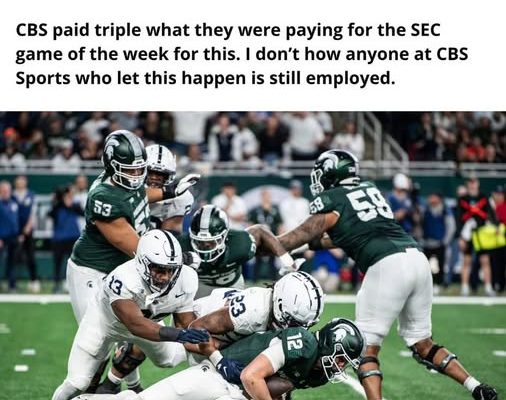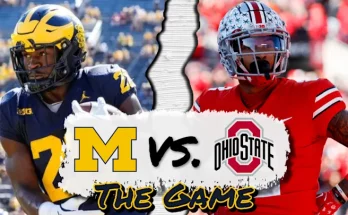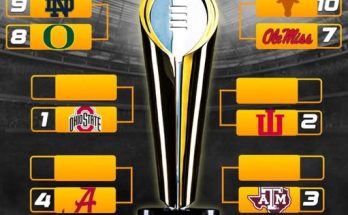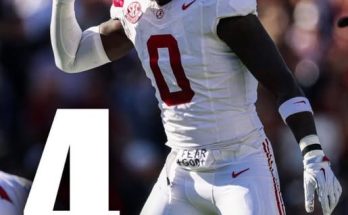In the complex, high‑stakes world of college football, television rights deals have become as much part of the game’s ecosystem as coaching changes, recruiting battles and conference realignments. Recently, the rival programs of Michigan State Spartans and Penn State Nittany Lions were featured in a broadcast on CBS—and while the game itself might be viewed by some as a “mid‑tier” matchup, the broader business contours suggest the network paid a significant sum just to land the rights to air it. The question becomes: what does it mean when a major network pays “millions” for what looks like a standard conference game? And what are the implications for the sport, the schools, the conference, and viewers?
At the heart of this story is the recently renegotiated media‑rights deal between the Big Ten Conference and its broadcast/streaming partners, including CBS, along with Fox Sports and NBC Universal / Peacock. The Big Ten announced a new seven‑year deal beginning July 1, 2023, running through the 2029‑30 season, reportedly worth more than $7 billion for the conference as a whole. TheWrap+3The Only Colors+3Black Shoe Diaries+3 Within that, CBS has signed on for a portion of the football package—including some “premium window” games on Saturdays. CBS Sports+1 One report indicated that for some of these 3:30 p.m. ET Big Ten games, CBS is paying around $350 million annually for the package. Front Office Sports+1 So when a Michigan State vs. Penn State game shows up on CBS in that window, it’s less about that one game, and more about a sliding‑scale of rights and exposure across dozens of games.
To unpack what’s going on, consider three broad angles: the cost side (what CBS is paying); the value side (what CBS hopes to get in return); and the downstream consequences (for schools like Michigan State and Penn State, for the Big Ten, and for fans).
The cost: paying for the package
CBS is not simply picking up a single matchup between Michigan State and Penn State. It is participating in a multi‑year rights agreement that bundles many games, many schools, many windows. The Big Ten’s deal is believed to distribute “$80‑$100 million per year” to each of its member institutions under the new structure. Onward State+1 While individual games are not priced publicly, the headline figure of “roughly $350 million per year” for CBS’s 3:30 p.m. Big Ten slot (as reported) suggests that you can divide that cost across perhaps 10‑15 games, meaning each game carries a not‑insignificant cost for the network when you look at rights‑allocation and marketing. That’s the structure: CBS is investing large sums to secure a block of games, one of which might be Michigan State vs. Penn State.
Importantly, the “millions” paid isn’t purely about the one matchup; it’s about securing network access, prime Saturday windows (when advertisers pay more), and the cachet of “national broadcast” status. Even if Michigan State vs. Penn State isn’t the marquee game of the weekend, it is part of a package for CBS that helps them fill a national time‑slot they’ve committed to, under a big rights deal.
The value: what CBS expects to get back
Why would CBS pay such sums? The network wants eyeballs, advertisers, affiliate stations happy, and sports‑marketing strength. College football is one of the few live events that still draw large, appointment‑viewing audiences in a fragmented media landscape. The Big Ten deal grants CBS a Saturday window at 3:30 p.m. ET (which had been dominated by the Southeastern Conference on other networks) and helps CBS remain competitive in the sports broadcast sector. Front Office Sports+1 For games like Michigan State vs. Penn State, CBS gets a national broadcast, which means advertisers will pay premium rates, affiliate stations in many markets will benefit, and CBS can promote its sports brand as “must‑see” college football. Even if the matchup is not the “top of the card,” those games still contribute to the package’s overall value.
From CBS’s perspective, the game is a piece of content that occupies a valuable broadcast window, draws fans of those programs and perhaps neutral viewers, and helps maintain the network’s stake in college sports. The fact that the Big Ten deal includes streaming rights and cross‑platform delivery means CBS is also investing for the future as audiences shift. CBS Sports+1 If the network did not secure the right number and quality of games, it risks losing relevance in the competitive sports broadcast space, especially with streaming and cable fragmentation.
Consequences for schools, conference and fans
For the schools involved—Michigan State and Penn State—being part of the Big Ten’s giant bundle means guaranteed revenue. The conference‑wide deal ensures that each member shares in the monies, which helps finance athletic departments, facilities, coaching, and scholarships. From the perspective of the schools, even “mid‑tier” games get elevated because they are part of a nationally televised package, which helps with recruiting, exposure and brand value.
For the Big Ten conference, the deal is transformational. It elevates the conference’s financial footing, aligns it with the highest levels of broadcast access, and positions Big Ten schools for future growth (especially as membership and realignment evolve). The deal is widely described as “NFL‑style” in its significance. WITF+2Black Shoe Diaries+2 The consequence is this: even games that might previously have been regional or less high profile now are part of the national broadcast mix, because the conference sold its rights in bulk.
For fans and viewers, there are mixed implications. On the positive side, watching your school on CBS means broad access, high production value, and national exposure. On the negative side, because every game in the package carries cost, networks may require more commercial time, may prioritize certain windows, or may push narratives that help bolster viewership (which can feel manufactured). Also, from a competition standpoint, the fact that revenue is so heavily tied to broadcast rights raises questions about parity—schools that attract more viewers may get more favorable assignments in broadcast packages.
The “mid‑tier” game quandary
A key piece of this scenario is that one could argue Michigan State vs. Penn State is not among the “elite” college football matchups (think Ohio State vs. Michigan, Alabama vs. Texas). So why would CBS devote significant resources to airing it? The answer lies in how broadcast networks categorize “tiers” of games and how they aim to fill windows. Within the Big Ten’s deal, CBS likely has rights to a certain number of football games each year. They may be obligated to carry everything from the marquee “big game” to lesser‑known matchups. In this sense, a game like Michigan State vs. Penn State becomes part of the value equation because it occupies a slot, helps fulfill contractual commitments, and contributes to the overall package.
Moreover, what is “mid‑tier” from one fan’s perspective may still carry enough national appeal to warrant broadcast. These schools have large alumni bases, recognizable programs, and national interest—even if the game isn’t the top headline. For CBS, filling that slot with a Big Ten game delivers predictable traffic. Also, the pricing for the rights was already baked in via the conference deal; the incremental cost of each individual game may be lower than one might assume (because the deal is amortized across many games). So while the headline “CBS paid millions for this one game” sounds dramatic, in a business‑sense it is part of a broader investment in the rights package.
Structural dynamics in play
What this situation underscores are several structural dynamics of modern college sports broadcast rights. First, the value of having network television slots on Saturdays remains high. Live sports remain one of the few major types of programming that draw appointment audiences. Second, conferences like the Big Ten are leveraging collective bargaining power to drive up values—aggregate deals worth billions are now the baseline. Third, networks are willing to pay large sums not necessarily for ultra‑premier games only, but for stable access to a portfolio of contests, because those contests bring multi‑platform opportunities (broadcast, digital, streaming). Fourth, there is a trickle‑down effect: even games between programs not at the very top receive broadcast platform, which changes fan expectations, recruiting perceptions, and institutional planning.
In the specific example of CBS airing a Michigan State vs. Penn State matchup, one might read it as a strategic move by the network to secure its 3:30 p.m. slot with a reliable Big Ten game. While the matchup may not headline the national discussion, it serves multiple functions: it fulfills a rights commitment, it maintains the brand of CBS as a major college‑football broadcaster, it exposes those schools to national spotlight, and it helps ensure advertisers and affiliates see value.
Why “millions” matters
When we say “millions” paid, this matters because it reflects how high the stakes have grown in college sports. It’s no longer just about regional broadcast deals or local radio rights; we are talking about national networks, window scheduling, streaming rights, conference realignment and massive financial commitments. The fact that CBS is cited as paying roughly $350 million annually for its share of Big Ten games means that even “one game” is a high‐value asset in an overall portfolio. And for the schools involved, being part of that asset means exposure, money, and competitive dynamics that impact everything from team budgets to recruiting.
Yet, it also raises pressing questions: Are schools being fairly compensated relative to what their games bring in? When networks pay huge sums yet still treat some games as “mid‑tier,” does that reflect a mismatch of value‑allocation? Do traditional power programs still dominate viewership and thus skew revenue distribution? From a broadcast lens, how many games can a network afford to carry before the marginal viewer interest drops and advertiser value declines?
Looking ahead
As we move forward, the repercussions of these broadcast deals will continue to ripple. If schools like Michigan State and Penn State find themselves on national broadcasts frequently, their recruiting and brand value may improve. If networks like CBS can sustain strong viewership for “mid‑tier” matchups, they justify paying for bulk rights. But if viewership declines for lesser games, networks might become more selective, pushing some games to lesser windows, streaming platforms, or pay‑walled access—raising concerns about accessibility for fans.
Furthermore, we’ll likely see increased pressure on the collegiate sport business model: the tens to hundreds of millions paid for rights must yield returns via advertising, platform subscriptions, affiliate fees or streaming deals. If they don’t, networks may re‑negotiate, reduce slots, or extract more favorable terms. For conferences, the race is on to keep expanding, realigning, or consolidating so their product remains “must‑see” to justify high rights fees. For fans, it means more national exposure, potentially more commercial breaks, perhaps more streaming fragmentation—and more games with broadcast contracts that make “mid‑tier” matchups look far more valuable in the economics of sport than they might feel from a casual fan’s vantage.



